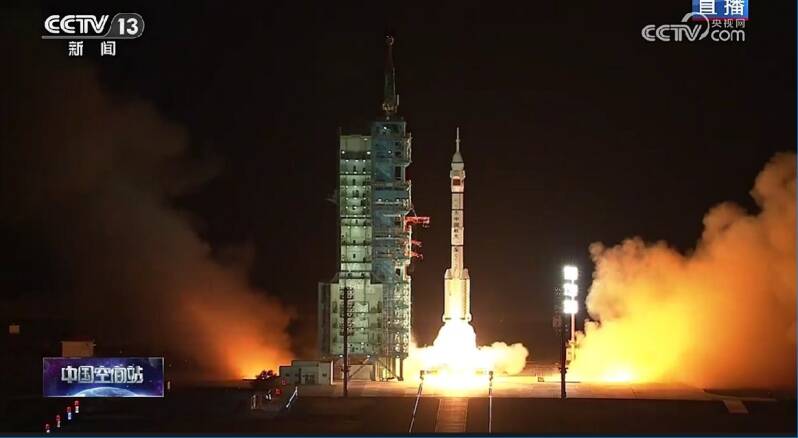The China National Space Administration (CNSA) launched the Shenzhou-19 spacecraft today, carrying three astronauts to the Tiangong Space Station. The mission aims to reinforce China’s growing presence in space, support Tiangong’s scientific operations, and continue China's broader aspirations of becoming a global space power.

Long March-2F Rocket lifted off with three astronauts from Jiuquan Satellite Launch Center. Credit: CCTV
A Milestone Mission
The launch took place at the Jiuquan Satellite Launch Center in northwest China, where the Shenzhou-19 spacecraft, mounted on a Long March-2F rocket, lifted off at 9:00 AM local time. The spacecraft is set to dock with the Tiangong Space Station, where the astronauts will conduct scientific experiments, maintain station operations, and prepare for future missions aimed at expanding human and scientific knowledge of space.
The crew aboard Shenzhou-19 includes Commander Zhang Wei, a veteran astronaut known for his work on previous missions; Li Xinyu, a space science specialist with a background in microgravity research; and Wu Jing, a seasoned engineer who will oversee the station's technical operations. This mission marks the fourth crewed expedition to Tiangong since its assembly in 2022, as China continues to demonstrate its commitment to long-duration human spaceflight and advanced space exploration.
Mission Objectives and Scientific Research
The Shenzhou-19 mission is expected to last six months, during which the astronauts will undertake a series of important scientific and technological tasks. Key objectives include conducting experiments in microgravity and biology, testing life support systems, and examining the impact of extended space travel on human health. These experiments are part of China’s long-term goal to contribute valuable data to the global scientific community, particularly in fields like biology, medicine, and physics.
One focal area for this mission is the study of plant growth in space, a critical area of research for future long-duration missions, such as potential lunar or Mars expeditions. The astronauts will also work on optimizing Tiangong’s automated systems, enhancing the station’s self-sufficiency and ensuring that it can operate independently for extended periods. This ability is seen as a stepping stone toward developing sustainable space habitats, a key objective of China's space program.
Expansion of Tiangong and Future Plans
Tiangong, which means "Heavenly Palace" in Mandarin, has rapidly become a centerpiece of China’s space ambitions. Launched as a modular space station, Tiangong consists of three main modules: the core Tianhe module, which houses the main living and work areas, and the Wentian and Mengtian science modules, which provide additional lab space for experiments.
Since its launch, the Tiangong station has functioned as China’s primary outpost in low Earth orbit, with its design and functionality comparable to the International Space Station (ISS). As the ISS nears its retirement, Tiangong is expected to play an increasingly significant role in global space research. CNSA officials have hinted at plans to invite international scientists to conduct experiments on the station, potentially opening the door to greater international collaboration.
China's future space ambitions include establishing a lunar research base in the 2030s and launching crewed missions to the Moon. To support these goals, CNSA is conducting advanced research on deep-space exploration technologies, life-support systems for long-duration missions, and propulsion systems for interplanetary travel.
The successful launch of Shenzhou-19 demonstrates China’s ability to conduct complex space missions, from crewed spaceflights to docking maneuvers in orbit. The Long March-2F rocket, a reliable workhorse of China’s crewed space program, has now launched multiple missions with a high degree of precision. This consistent track record has bolstered confidence in China's space capabilities and showcases the nation’s progress in space technology.
China’s advancements in space exploration extend beyond manned missions. The nation has successfully landed and operated rovers on the Moon and Mars, conducted lunar sample return missions, and launched a range of scientific satellites. These achievements place China at the forefront of space exploration, on par with agencies like NASA, ESA, and Roscosmos.
China’s growing space presence is reshaping the dynamics of space exploration, prompting responses from other spacefaring nations. While the Tiangong station operates independently of the International Space Station, China’s leadership has expressed interest in international cooperation. The Tiangong station’s capacity to host foreign astronauts and scientists presents a unique opportunity for collaboration, particularly as the ISS winds down its operations.
The Shenzhou-19 mission underscores China's determination to carve out a leading role in space. Experts say that China's continued success in space exploration will likely drive other nations to either collaborate or compete, setting the stage for an exciting new era in space science and exploration.
What’s next for Shenzhou-19 and the Tiangong Crew
In the coming months, the Shenzhou-19 crew will carry out a range of scientific experiments, spacewalks, and routine maintenance tasks. With an increased focus on testing and maintaining life-support and environmental control systems, the mission aims to make life aboard the Tiangong station more sustainable and adaptable for future missions. These operations are part of CNSA's preparation for extended missions beyond Earth orbit, contributing valuable experience as China plans for a lunar presence and, eventually, human missions to Mars.
With Shenzhou-19 now on its way to the Tiangong Space Station, China has once again demonstrated that it is a serious contender in the arena of human spaceflight. The mission’s success could well mark the beginning of a new chapter in space exploration, one where Tiangong becomes a key asset for scientific research and international cooperation.


Add comment
Comments